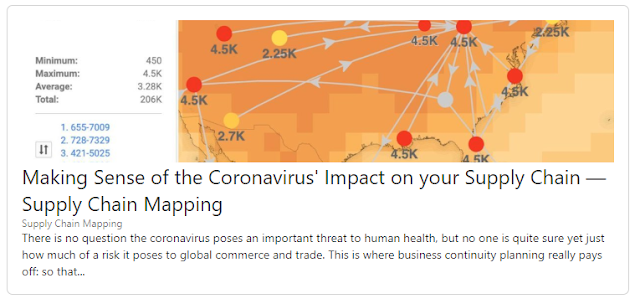 |
| Photo Credit; VIACOM-CBS. Like Captain Picard of the USS Enterprise, leadership will have to steer the ship safely through the battlefield |
BUSINESS UNUSUAL: BACK-TO-WORK PLANNING GUIDELINES AND RESOURCES FOR COVID-19 READINESS
READING TIME: 4 min
This article was originally published on LinkedIn - you can read the original post here.
For many organisations, reopening might not simply be a case of unlocking the doors and switching the lights back on. Quite a lot might have happened while nothing happened during the lockdown.
The following is a high-level checklist / key considerations for executives and business owners alike. Additional South African and international resources are provided at the end of the article, some of which contain detailed examples, boilerplate templates, etc.
While some of the references specifically refer to South African business law and requirements, the recommendations are generic and applicable to businesses in various countries
1. Conduct an Overall Assessment
Brace yourself - while the damage or impact of the lockdown might not be immediately visible or easily identifiable the moment you walk back through the doors, the organisation might have "sprung a leak below the waterline” (metaphorically speaking). There is also the very real possibility of a future risk event that might still fully unfold in the next few weeks or months (e.g. as a consequence of the chosen strategy, implementation thereof, and extent of compliance with regulations, or other factors).
Conduct a thorough and comprehensive assessment to determine the impact of the lockdown/virus to date on:
- Staff and management
- Business Assets, Stock, IT systems
- Other Stakeholders – customers, suppliers, shareholders, creditors, landlords, regulators, etc.
- Business operations
- Business Finances and Cashflow
2. Understand the requirement of the various Stages and Regulations of the Disaster Management Act [1] and its impact on your strategy, operating model, and plan corrective action:
- Establish a Covid19 Task Team (if you have not done so yet, and appoint specific COVID19 Compliance Officer(s) ), co-opt expertise and allocate responsibilities and develop a strategy as well as supporting policies.
- Confirm if and when your business or organisation qualifies to open and trade during a specific Phase of the lockdown. Also, confirm whether or not any additional permits are required. If unclear or if your specific organisation falls in a grey area which is not spelt out in the Emergency Regulations, contact your legal advisor and obtain professional legal advice.
- Take the time to do a detailed impact assessment to understand exactly what the requirements for each phase are, and how these may impact both your organisation as well as the wider industry in which you operate. Note that there are different requirements for different sizes, types of businesses and industries which might affect locations or different types of outlets differently.
- In real-world terms, these requirements could affect the date that your business can practically open for business because these measures need to be put in place first, e.g. steps to ensure social distancing, preventing crowding in admin offices or public spaces like the staff canteen, or while customers wait for quotes or while collecting goods. This is also impacted by the required level of hygiene, PPE for employees, additional safety requirements, etc.
- Consider whether the business operations should be suspended, and if not, which products and services can be offered now, vs. phased in subsequently in compliance with lockdown regulations.
- Plan the necessary workforce and capacity requirements accordingly.
- Demand planning may require a rethink, as well as any impact of these changes on outsourced services and contracts where capacity might have to be reallocated in the short run, in consultation with service providers.
- Reopening requires a high degree of Response Preparedness [12], and may necessitate Scenario planning – e.g. how will you handle a situation where the company operates across multiple provinces, but some of these provinces operate under different phases (e.g. Phase 5 or Phase 3)
- Return-To-Work Policies, updated HR and Operational Policies and Procedures,
- Risk and Hazard assessments and Preventative Measures,
- Compliance Checklists

3. Review of Financial position
- Do not arbitrarily increase prices to make up for losses or to profiteer from market shortages [15]
- Carry out a line-by-line analysis of expenses to determine minimum cost and strategies to curtail costs until business conditions improve,
- Determine restructuring costs (if applicable) as well as Covid-19 related expenses, and bring these into consideration when completely re-working the budgets, forecasts, projections and cash flow. Communicate these changes to the line managers,
- Review solvency and liquidity, financing arrangements and debt repayments,
- Review and (re)negotiate trading terms with a view to optimise liquidity and maximise working capital.
4. Consider Occupational Health & Safety requirements[3] and Sectoral or Industry Guidelines:
New risk assessments are required that could necessitate amendments to existing Risk Management as well as HR policies, AND special measures to be implemented such as proper social distancing, action plans in case of infection or symptom screening, etc. Existing Risk management policies and procedures will have to be updated (refer to Point 9 below).The OHSA further requires employers, to ensure, as far as is reasonably practicable, that all persons who may be directly affected by their activities (including but not limited to own employees, customers, clients, contractors who enter their workplace or come into contact with their employees) are not exposed to hazards to their health or safety.
 |
| Source: https://www.zupermar.com/ |
- For one business this might require social distancing, supplying employees with PPE and hand sanitizers while electronically screening customers for fever at the door and recording their details. Note the Department of Trade and Industry published requirements for material masks
 |
| Source: Gautrain Whole-body Disinfection |
- For another, this might e.g. require intermittent professional disinfecting of public areas and or equipment or further steps.
5. Review the Supply Chain:
Supply chains and logistics could have been significantly affected due to:- Supplier factory lockdowns,
- delayed raw material shipments or stockouts,
- import delays due to ships unable to dock at ports or air cargo curbed,
- warehouses might have limited capacity to accept new stock,
- some stock items might have spoiled or deteriorated or might simply be unavailable for an undefined period.
- Review stock levels, re-order levels (specifically where programmed/automated re-order levels exist) and investigate outstanding orders. Ensure that no artificial shortages are created in the process [15].
- Re-rate suppliers: consider supplier resilience, flexibility under fluctuating demand and ultimately, supplier reliability,
- Reassess respectively, the degree of visibility, and the viability of the current supply chain – resources and capacity might have to be rebalanced.
6. HR considerations, Staff Planning and Consultation
The Department of Labour communicated stringent requirements in a briefing by Labour Minister Thulas Nxesi on 3 May 2020 (view on Youtube). The media statement with transcribed speech can be found here [16].Consider staffing capacity requirements and re-activation, e.g.:
- identifying specific staff members forming part of the first 30% or applicable regulated percentage for your type of business,
- vs each subsequent wave as lockdown restrictions are gradually lifted.
- This will require a detail situational assessment to e.g. deal with employees currently based in other provinces or other cities.
Consider flexible work arrangements such as:
- staff rotation,
- or continued working from home,
- and how IT can be used to your benefit to reduce the need for clients or staff to come to the office.
7. Assess the IT landscape
Consider the potential impact of changes in business operations on critical infrastructure, systems, and processes, e.g.:- Productivity software to improve work-from-home efficiency and productivity,
- Disinfecting of keyboards, electronic equipment, access control equipment, and or contactless alternatives for time and access control systems,
- Consider increased IT risks (refer to point 9 below).
 |
| Source: Youtube Fever Screening Solution |
8. Legal Review: Contracts, SLAs and Projects, ongoing Litigation and Disputes
Stay on top of existing litigation and disputes pre-dating the pandemic.
Investigate and identify any potential new contract breaches, terms not complied with, obligations not met, situations where performance was delayed, partially or completely withheld, where deliverables and deadlines were missed during the lockdown – both from the viewpoint where:
Investigate and identify any potential new contract breaches, terms not complied with, obligations not met, situations where performance was delayed, partially or completely withheld, where deliverables and deadlines were missed during the lockdown – both from the viewpoint where:
- your organization is the recipient of goods or services, as well as where
- your organization is the provider of goods or services.
- Obtain professional legal advice – some situations might be remedied with respectful and mutually pragmatic (re)negotiation.
- Standard contracts, terms and conditions might need some improvement going forward.
9. Governance and Risk management
Be mindful of Directors
Duties [4] in general, and specifically under Covid19 conditions (see
resources here [5]
and here [6])
where financial
distress [7] poses a very real risk. Review your risk management
plans.
- Consider any additional governance/reporting requirements [2][3].
- Consider increased IT-related risks (e.g. cybercrimes such phishing, malicious websites, and malware [9]) targeting a distributed workforce, or leaking of information [10].
- Institute strict record-keeping and improve overall risk management[11], including but not limited to OHS/PPE compliance and fever temperature screening. Accurate and complete record keeping will be crucial as the new Emergency Regulations appear to shift the onus and burden of proof onto the employer.
- Review insurance policies, business interruption, liability cover, etc.
- When in any doubt, obtain legal advice.
10. Stakeholder management
Communicate as may be required with, and monitor communication from certain stakeholders including Staff, Customers, Suppliers, Shareholders, Creditors, Landlords, Regulators, Government, Other interested parties.Conclusion:
Successfully navigating the risk and many pitfalls of the Covid-19 crisis will require leadership, teamwork, frequent measurement, and adapting the plan and operations to changes in the environment from time to time.
If you found the article helpful or interesting, please feel free to share.

---------------------------------------
Resources*: The following resources were consulted in the compilation of this article.
[1] https://www.gov.za/documents/disaster-management-act-regulations-29-apr-2020-0000
[2]https://neasa.co.za/covid-19-return-to-work-toolkit/
[3] http://www.gpwonline.co.za/Gazettes/Gazettes/43257_29-04_Labour.pdf
[4] https://www2.deloitte.com/content/dam/Deloitte/za/Documents/governance-risk-compliance/ZA_DutiesOfDirectors2013_16042014.pdf
[5] https://www.werksmans.com/firm-news/covid-19-duties-of-directors/
[6] https://www.financialinstitutionslegalsnapshot.com/2020/04/managing-a-company-and-covid-19-south-african-directors-and-their-duties/
[7] https://www.bowmanslaw.com/insights/restructuring/covid-19-financial-distress-insolvency-and-restructuring/
[8] https://www.ansarada.com/ COVID-19 resources
[9]https://www.riskiq.com/blog/analyst/covid19-cybercrime-update/
[10]https://www.ensafrica.com/news/detail/2651/south-africa-coronavirus-covid-19-how-to-avoi/
[11] https://www.aon.com/event-response/coronavirus.aspx (generic but valuable information)
[12] https://www.aon.com/COVIDplanningtoolkit/default (generic but valuable information)
[13]https://www.lexisnexis.co.za/news-and-insights/covid-19-resource-centre
[14]http://www.treasury.gov.za/comm_media/press/2020/Annexure%20B%20-%20Recommended%20Guidelines%20Fabric%20Face%20Masks%20RSA%20DTIC.pdf
[15] https://www.bowmanslaw.com/insights/competition/excessive-pricing-in-south-africa-in-the-age-of-covid-19-2/
[16] https://www.gov.za/speeches/minister-thulas-nxesi-directions-coronavirus-covid-19-alert-level-4-3-may-2020-0000
*Information made available in the public interest and shared in good faith.
Respective sources remain fully responsible and liable for the accuracy of the
information published by them.
** All artwork and photos remain the property of their respective owners.




















